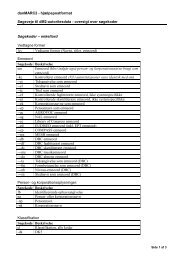RFID Data Model for Libraries - biblstandard
RFID Data Model for Libraries - biblstandard
RFID Data Model for Libraries - biblstandard
You also want an ePaper? Increase the reach of your titles
YUMPU automatically turns print PDFs into web optimized ePapers that Google loves.
<strong>RFID</strong> <strong>Data</strong> model <strong>for</strong> libraries Doc 067<br />
Order number<br />
An order number <strong>for</strong> the item. Decided by the library and the supplier.<br />
Invoice number<br />
An invoice number <strong>for</strong> the item<br />
The optional data elements:<br />
• Supplier ID<br />
• Item identification<br />
• Order number<br />
• Invoice number<br />
are related to assist the process between an item supplier and the library. It can be <strong>for</strong>eseen<br />
that some media suppliers wish to extend their services so that supplied media are ready-made<br />
with <strong>RFID</strong> tags pre-written with data on an agreement with the library. At the same time data<br />
from the supplier can assist the acquisition process in the library and also the accounting<br />
checking in the library. The supplier can also benefit by using the data in an automated<br />
storage and packing facility.<br />
The data elements can later be overwritten to save space and maybe <strong>for</strong> reasons put <strong>for</strong>ward<br />
by data protection agencies. However, the supplier ID could be preserved in case of later<br />
complaints.<br />
Unstructured extension data blocks<br />
For obvious reasons nothing is specified about the contents of the unstructured data blocks.<br />
This can be controlled by either the vendor or the library.<br />
2.4 Encoding<br />
The encoding of <strong>RFID</strong> tags is a delicate job. The space available in a tag is still rather limited<br />
<strong>for</strong> the cost-conscious buyer and vendor. The encoding issue may be the most pertinent <strong>for</strong> a<br />
successful data model.<br />
Three factors can be observed as important<br />
• There are no general guidelines in the present set of generic standards on how to introduce<br />
encoding<br />
• The limited capacity of <strong>RFID</strong> tags call <strong>for</strong> rather compressed solutions<br />
• To facilitate fast operation in the use of <strong>RFID</strong> tags a set of in<strong>for</strong>mation shall physically be<br />
located at the same place in every tag.<br />
See also Annex B: Empirical test results. Inventory Operation Per<strong>for</strong>mances versus Read<br />
Memory Size.<br />
General on encoding<br />
Several methods of high sophistication exist in encoding procedures. These methods will<br />
often end in a floating designation of data. This will not speed up reading and writing<br />
procedures.<br />
17




